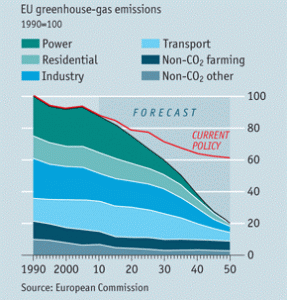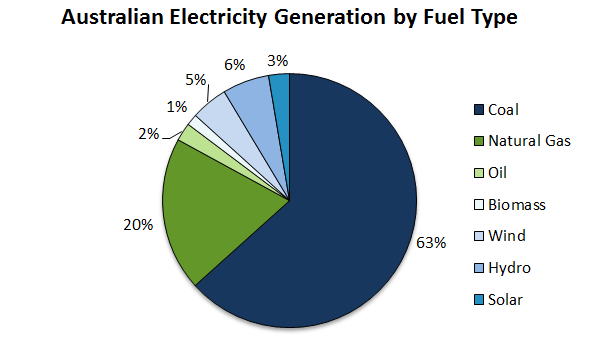by Daniel Firger
Associate Director
Europe is doubling down on decarbonization.
On March 8, 2011, the European Commission (EC) released its widely anticipated “roadmap for moving to a competitive low carbon economy in 2050.” The roadmap calls for both short- and longer-term cuts in EU-wide GHG emissions: 20% below 1990 levels by 2020, and reductions of 80% against the same baseline by 2050. These ambitious targets mark Europe as the world’s most aggressive player on climate change (with the important exception of a handful of Small Island Developing States, who stand to lose everything from sea level rise).
As Europe’s executive body, the EC cannot promulgate legislation itself. However, EC communications may set guidelines and establish benchmarks for formal lawmaking by the European Parliament, which is in turn implemented at both the EU level and in the legislatures of Member States. A close examination of the roadmap can therefore reveal important clues about how future EU – and international – climate policy will take shape.
The roadmap situates European climate objectives within the larger context of the EU’s “2020 Strategy for smart, sustainable and inclusive growth.” This document sets targets in five broad policy areas, one of which covers climate and energy. The roadmap is also anchored by the goal of preventing more than 2 degrees (Celsius) of warming, which the international community agreed in Copenhagen is necessary to achieve the UNFCCC-mandated aim of preventing “dangerous anthropogenic interference with the climate system.” Taken together, these two preexisting commitments necessitate a comprehensive, continent-wide plan to achieve low carbon growth over the coming decades. The roadmap represents Europe’s plan.
Taking a broad sectoral approach, the EC document outlines the potential for GHG emissions reductions from the following areas:
(i) Power;
(ii) Industry;
(iii) Transport (including aviation, but excluding maritime);
(iv) Residential buildings; and
(v) Agriculture (non-CO2 emissions)
(vi) Other non-CO2 emissions

Power
The roadmap projects nearly 100% decarbonization of the power sector by 2050, at an anticipated cost of roughly €30 billion ($42 billion) per year over 40 years. This represents a big jump from the current 45% share of low carbon technologies in the electricity mix and the anticipated 60% share such technologies will represent in 2020. Technologies include not only solar, wind, biomass, and hydropower, but also nuclear energy and as-yet-proven carbon capture and storage (CCS) techniques to remove CO2 from fossil fuel-fired electricity generating facilities.
Furthermore, the variable output of many renewable energy technologies will require the construction of new smart grids and transmission networks. Technological innovation and investment in all of these areas is expected to be driven in large part by the EU Emissions Trading System (EU ETS), which must create a strong carbon price signal and establish long-term predictability in order to be effective.
Notably, European policymakers may need to reexamine their assumptions regarding future reliance on nuclear energy in light of the partial meltdown of the Fukushima nuclear power plant following the Japanese earthquake and tsunami on March 11. Indeed, on March 15 Germany became the first European country to temporarily shut down nuclear power plants in the wake of the Japanese crisis, while the “European Union made plans to test all 143 nuclear power plants in its 27 countries,” according to the New York Times. Likewise, recent unrest in North Africa is calling into question the viability of European plans for large-scale solar projects in the region. Without a stable or growing share of European power coming from nuclear reactors and solar PV, and without viable and cost effective CCS technology, the roadmap’s 2020 and 2050 targets for decarbonization will be much harder to achieve.
Industry
EC analysis has identified pathways to achieve 83 to 87% reductions in GHG emissions in the industrial sector by 2050. In particular, the roadmap identifies low-hanging fruit in energy intensive industries, including efficiency gains, increased recycling, and readily available abatement technologies for non-CO2 emissions such as methane and nitrous oxide. The roadmap acknowledges that “broad scale” deployment of CCS after 2035 will be necessary to achieve further reductions, and projects required annual investment in CCS at more than €10 billion ($14 billion).
The roadmap identifies key competitiveness and carbon leakage concerns associated with energy intensive industries with international markets, such as steel and cement, and calls for further monitoring of climate efforts by third countries in order to protect domestic industries.
Transportation
Up until 2025, the roadmap anticipates that increased fuel efficiency will drive reductions in GHG emissions in the transportation sector. After that, electrification of the vehicle fleet and/or the use of sustainable biofuels will play a larger role, together with policy measures such as pricing schemes targeting congestion and air pollution and new investments in public transportation. Costs are projected at €150 billion ($209 billion) per year over the next forty years.
Residential
The roadmap lays out ambitious targets for the energy efficiency of buildings, relying in large part on a 2010 EU Directive that requires that new buildings built from 2021 onwards must be nearly zero-energy. However, it also identifies a major impediment: financing for refurbishing and retrofitting existing building stock, which it projects will cost €80 billion ($112 billion) per year through 2050.
Agriculture
Non-CO2 agricultural emissions can be slashed by nearly half by 2050, according to EC analysis. Efficient fertilizer use, gasification of organic manure, and other measures will help to achieve these cuts, but clearly the bulk of agricultural CO2 emissions will remain. In fact, the roadmap projects that agriculture will be responsible for a third of total EU emissions in 2050, “tripling it shared compared to today.” In the context of global population growth, the roadmap highlights the importance of comprehensive international policies on land use, land use change and forestry (LULUCF), including those under the rubric of reduced emissions from deforestation an degradation (REDD).
Needed Capital Investments:
In order to achieve EU climate goals, the roadmap projects annualized costs of €270 billion ($377 billion) over the next four decades, representing roughly 1.5% of EU GDP per year. Aligning itself with the new international climate finance framework taking shape via the Copenhagen and Cancun commitments, the roadmap identifies the need for new financing models and smart policymaking to “unlock[ ] the investment potential of the private sector . . . [and] overcome initial financing risks and cash flow barriers.” Some recommendations include revolving funds, guarantee schemes, and an increased role for leveraged public finance via the European Investment bank and the European Bank for Reconstruction and Development.
International Impacts:
One of the most important features of the roadmap is the commitment to reduce domestic emissions by 80% by 2050 compared to 1990 levels. In a footnote, the document explains that domestic in this context means “real internal reductions of EU emissions and not offsetting through the carbon market.” Taken at face value, this commitment has enormous implications not only for the European Emissions Trading System (EU ETS), which currently allows international offsets through the Clean Development Mechanism (CDM) and other programs, but also for international mitigation and adaptation programs, many of which rely heavily on offsetting as a means to generate revenue for projects in the developing world.
While the roadmap is a far cry from a comprehensive legislative program on climate change, its mere existence highlights the stark fact that the state of the climate debate in Europe is almost precisely the polar opposite of that in the United States. While Republicans in the U.S. House of Representatives are holding raucous hearings on climate science and climate regulation (EPA Administrator Lisa Jackson recently gained the dubious distinction of having testified more often than any other cabinet official this year), Brussels parliamentarians are working hard to implement many of the roadmap’s recommendations.
Of course, as the Economist recently pointed out, “there is a big difference between drawing a map and following it.” Yet a roadmap nevertheless provides a clear destination and a desired pathway to get there. For all its ambiguities, assumptions, and lacunae, the roadmap is a profound political statement from Europe about its plans for the future. Climate wonks the world over would do well to familiarize themselves with the document.
Associate Director and Fellow, Center for Climate Change Law


